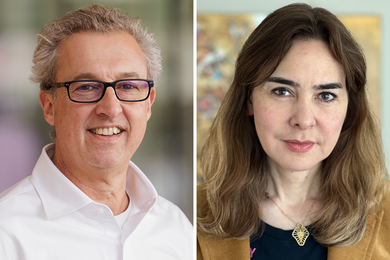The John D. and Catherine T. MacArthur Foundation unveiled that a proactive climate resilience system co-developed by MIT and BRAC, a leading development organization, was one of the highest-scoring proposals, designated as the Top 100, in its 100&Change competition in 2020 for a single $100 million grant to help solve one of the world's most critical social challenges.
The MIT/BRAC system, known as the Climate Resilience Early Warning System Network (CREWSNET), aims to empower climate‑threatened populations to make timely, science-driven decisions about their future. Starting with western Bangladesh but scalable to other frontline nations across the globe, CREWSNET will combine leading-edge climate forecasting and socioeconomic analysis with innovative resilience services to enable people to make and implement informed decisions about adaptation and relocation — and thereby minimize loss of life, livelihoods, and property.
“Climate change is one of the most urgent threats facing human civilization today, and while the world’s most vulnerable did not create this challenge, they are the first to inherit it,” said John Aldridge, assistant leader of the Humanitarian Assistance and Disaster Relief Systems Group at MIT Lincoln Laboratory who serves as a CREWSNET project leader along with principal investigator Elfatih Eltahir, the Breene M. Kerr Professor of Hydrology and Climate at MIT. “We at MIT are excited and proud to have partnered with BRAC, a proven, global leader in humanitarian assistance and development programming, to create a new, proactive model for climate adaptation and individual empowerment.”
“In its earliest days, BRAC worked tirelessly to rebuild communities devastated by climate disasters. Almost 50 years later, we continue to innovate our poverty alleviation and climate change adaptation programming, which reaches tens of millions of people each year. We are thrilled to partner with MIT now to incorporate their advanced technology, research, and scientific capabilities to tackle the myriad of challenges created by climate change, first in Bangladesh and then globally,” says Ashley Toombs, director of External Affairs at BRAC USA, the U.S.-based affiliate, whose portfolio includes climate change adaptation.
100&Change is a distinctive competition that is open to organizations and collaborations working in any field, anywhere in the world. Proposals must identify a problem and offer a solution that promises significant and durable change. The second round of the competition had a promising start: 3,690 competition registrants submitted 755 proposals. Of those, 475 passed an initial administrative review.
The Top 100 represent the top 21 percent of competition submissions. The proposals were rigorously vetted, undergoing MacArthur’s initial administrative review, a Peer-to-Peer review, an evaluation by an external panel of judges, and a technical review by specialists whose expertise was matched to the project.
Each proposal was evaluated using four criteria: impactful, evidence-based, feasible, and durable. MacArthur’s board of directors will select up to 10 finalists from among these high-scoring proposals this spring.
“MacArthur seeks to generate increased recognition, exposure, and support for the high-impact ideas designated as the Top 100,” says Cecilia Conrad, CEO of Lever for Change and MacArthur managing director at 100&Change. “Based on our experience in the first round of 100&Change, we know the competition will produce multiple compelling and fundable ideas. We are committed to matching philanthropists with powerful solutions and problem solvers to accelerate social change.”
Since the inaugural competition, other funders and philanthropists have committed an additional $419 million to date to support bold solutions by 100&Change applicants. Building on the success of 100&Change, MacArthur created Lever for Change to unlock significant philanthropic capital by helping donors find and fund vetted, high-impact opportunities through the design and management of customized competitions. In addition to 100&Change, Lever for Change is managing the Chicago Prize, the Economic Opportunity Challenge, and the Larsen Lam ICONIQ Impact Award.
The Bold Solutions Network launched on Feb. 19, featuring CREWSNET as one of the Top 100 from 100&Change. The searchable online collection of submissions contains a project overview, 90-second video, and two-page factsheet for each proposal. Visitors can sort by subject, location, sustainable development goal, or beneficiary population to view proposals based on area of interest.
The Bold Solutions Network will showcase the highest-rated proposals that emerge from the competitions Lever for Change manages. Proposals in the Bold Solutions Network undergo extensive evaluation and due diligence to ensure each solution promises real and measurable progress to accelerate social change.
The Bold Solutions Network was designed to provide an innovative approach to identifying the most effective, enduring solutions aligned with donors’ philanthropic goals and to help top applicants gain visibility and funding from a wide array of funders. Organizations that are part of the network will have continued access to a variety of technical support and learning opportunities focused on strengthening their proposals and increasing the impact of their work.







